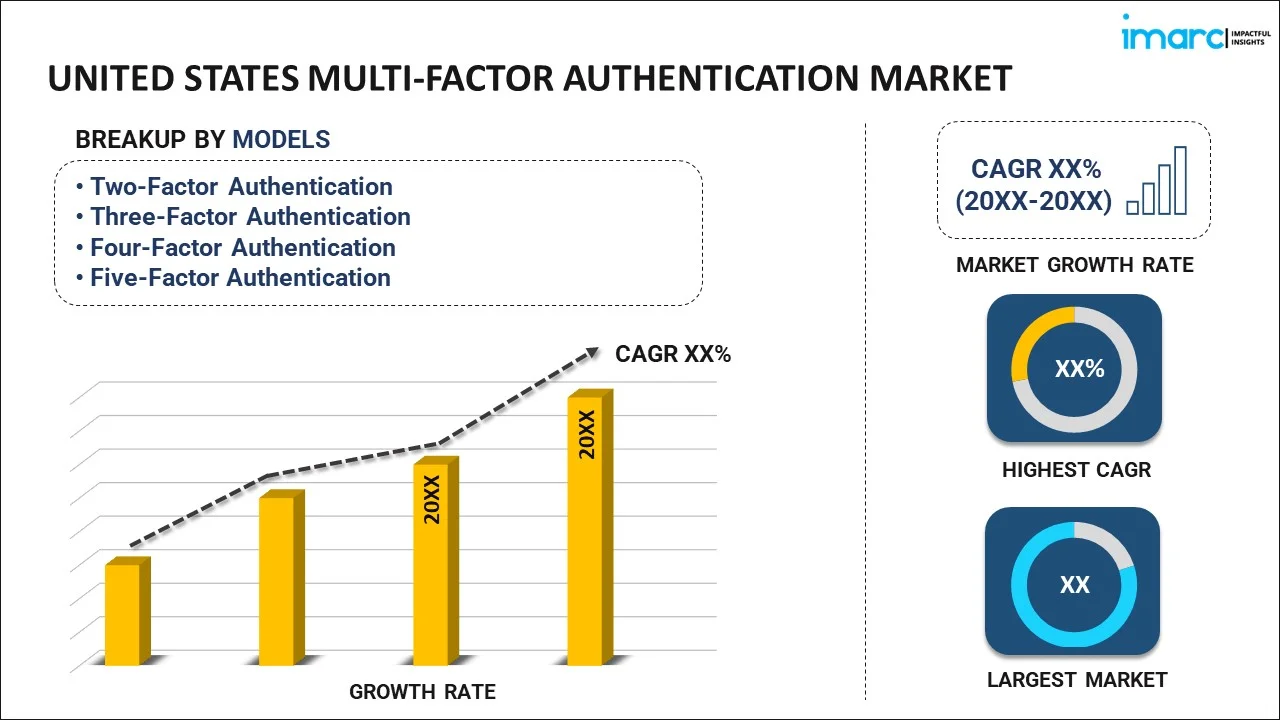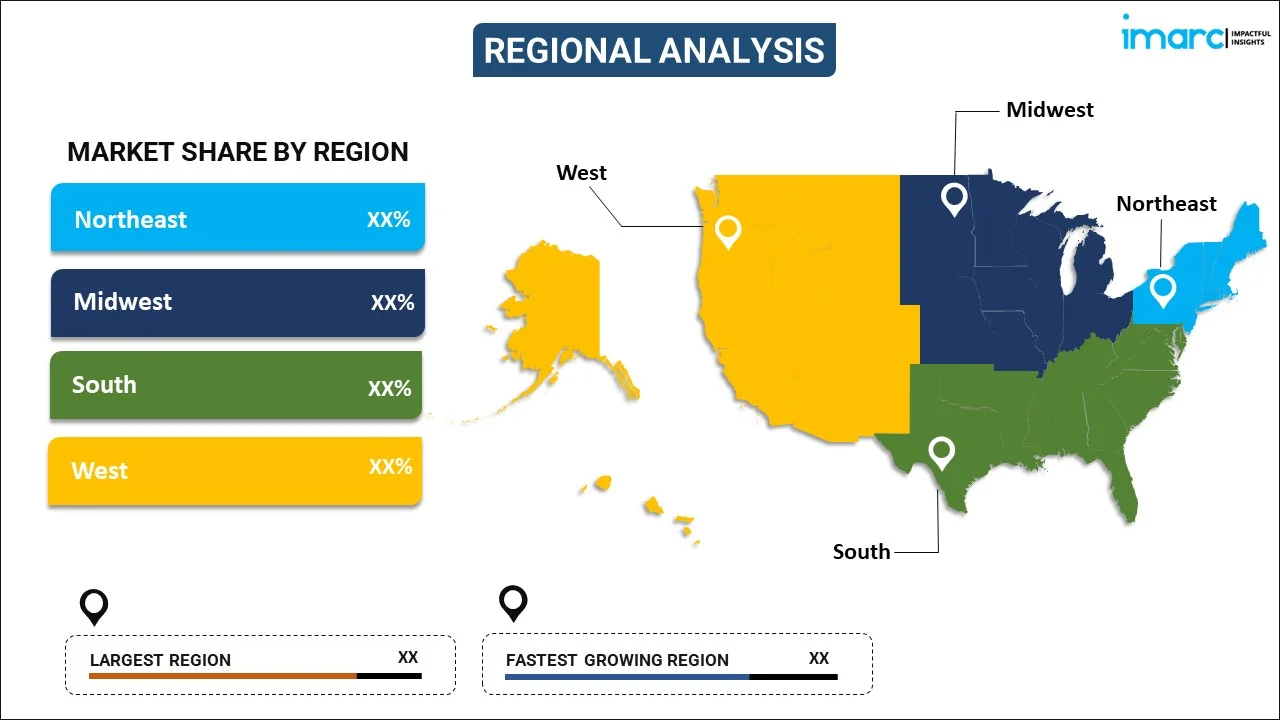
United States Multi-factor Authentication Market Report by Model (Two-Factor Authentication, Three-Factor Authentication, Four-Factor Authentication, Five-Factor Authentication), Deployment Type (On-Premises, On-Cloud), Application (Smart Card Authentication, Phone-Based Authentication, Hardware OTP Token Authentication), Vertical (Banking and Finance, Government, Travel and Immigration, Military and Defence, IT and Telecom, Healthcare, Retail and Ecommerce, and Others), and Region 2025-2033
Market Overview:
United States multi-factor authentication market size reached USD 5.1 Billion in 2024. Looking forward, IMARC Group expects the market to reach USD 18.1 Billion by 2033, exhibiting a growth rate (CAGR) of 15% during 2025-2033. The rising focus on data privacy and security regulations, along with the widespread adoption of advanced cybersecurity solutions, is primarily driving the market growth.
|
Report Attribute
|
Key Statistics
|
|---|---|
|
Base Year
|
2024
|
|
Forecast Years
|
2025-2033
|
|
Historical Years
|
2019-2024
|
|
Market Size in 2024
|
USD 5.1 Billion |
|
Market Forecast in 2033
|
USD 18.1 Billion |
| Market Growth Rate 2025-2033 | 15% |
Multi-factor authentication (MFA) is a sophisticated security protocol engineered to elevate the safeguarding of digital accounts and systems. The mechanism mandates users to furnish multiple forms of identification, encompassing elements like passwords, fingerprints, or facial recognition, to obtain access. By demanding this multi-layered approach, multi-factor authentication effectively fortifies security, introducing heightened complexity for unauthorized individuals attempting to compromise accounts or systems. Its primary function is to bolster the defense against fraud and threats, contributing to an escalating demand for MFA as a pivotal security measure.
United States Multi-factor Authentication Market Trends:
The United States multi-factor authentication market is experiencing robust growth as organizations prioritize advanced security measures to protect digital assets and sensitive information. Additionally, MFA, functioning as an intricate security protocol, demands users to provide multiple forms of identification, such as passwords, fingerprints, or facial recognition, for access to digital accounts and systems, which is acting as another significant growth-inducing factor. Besides this, in an era where cybersecurity threats are escalating, the U.S. multi-factor authentication market is becoming increasingly indispensable across various sectors. Furthermore, its role in fortifying security by introducing additional layers of authentication makes it more challenging for unauthorized individuals to breach accounts or systems, thereby positively influencing the market growth. In line with this, the heightened awareness of fraud prevention and the need for robust cybersecurity solutions contribute to the rising demand for MFA in the United States, thereby bolstering the regional market. Moreover, this market's trajectory is fueled by the continual evolution of cyber threats and the recognition that a multi-layered authentication approach is essential in safeguarding sensitive data. Apart from this, as businesses and individuals alike prioritize the protection of digital identities, the United States multi-factor authentication market is poised for sustained growth, playing a crucial role in enhancing the overall cybersecurity landscape over the forecasted period.
United States Multi-factor Authentication Market Segmentation:
IMARC Group provides an analysis of the key trends in each segment of the market, along with forecasts at the country level for 2025-2033. Our report has categorized the market based on model, deployment type, application, and vertical.
Model Insights:

- Two-Factor Authentication
- Three-Factor Authentication
- Four-Factor Authentication
- Five-Factor Authentication
The report has provided a detailed breakup and analysis of the market based on the model. This includes two-factor authentication, three-factor authentication, four-factor authentication, and five-factor authentication.
Deployment Type Insights:
- On-Premises
- On-Cloud
A detailed breakup and analysis of the market based on the deployment type have also been provided in the report. This includes on-premises and on-cloud.
Application Insights:
- Smart Card Authentication
- Phone-Based Authentication
- Hardware OTP Token Authentication
The report has provided a detailed breakup and analysis of the market based on the application. This includes smart card authentication, phone-based authentication, and hardware OTP token authentication.
Vertical Insights:
- Banking and Finance
- Government
- Travel and Immigration
- Military and Defence
- IT and Telecom
- Healthcare
- Retail and Ecommerce
- Others
A detailed breakup and analysis of the market based on the vertical have also been provided in the report. This includes banking and finance, government, travel and immigration, military and defence, IT and telecom, healthcare, retail and ecommerce, and others.
Regional Insights:

- Northeast
- Midwest
- South
- West
The report has also provided a comprehensive analysis of all the major regional markets, which include Northeast, Midwest, South, and West.
Competitive Landscape:
The market research report has also provided a comprehensive analysis of the competitive landscape. Competitive analysis such as market structure, key player positioning, top winning strategies, competitive dashboard, and company evaluation quadrant has been covered in the report. Also, detailed profiles of all major companies have been provided.
United States Multi-factor Authentication Market Report Coverage:
| Report Features | Details |
|---|---|
| Base Year of the Analysis | 2024 |
| Historical Period | 2019-2024 |
| Forecast Period | 2025-2033 |
| Units | Billion USD |
| Scope of the Report | Exploration of Historical and Forecast Trends, Industry Catalysts and Challenges, Segment-Wise Historical and Predictive Market Assessment:
|
| Models Covered | Two-Factor Authentication, Three-Factor Authentication, Four-Factor Authentication, Five-Factor Authentication |
| Deployment Types Covered | On-Premises, On-Cloud |
| Applications Covered | Smart Card Authentication, Phone-Based Authentication, Hardware OTP Token Authentication |
| Verticals Covered | Banking and Finance, Government, Travel and Immigration, Military and Defence, IT and Telecom, Healthcare, Retail and Ecommerce, Others |
| Regions Covered | Northeast, Midwest, South, West |
| Customization Scope | 10% Free Customization |
| Post-Sale Analyst Support | 10-12 Weeks |
| Delivery Format | PDF and Excel through Email (We can also provide the editable version of the report in PPT/Word format on special request) |
Key Questions Answered in This Report:
- How has the United States multi-factor authentication market performed so far and how will it perform in the coming years?
- What has been the impact of COVID-19 on the United States multi-factor authentication market?
- What is the breakup of the United States multi-factor authentication market on the basis of model?
- What is the breakup of the United States multi-factor authentication market on the basis of deployment type?
- What is the breakup of the United States multi-factor authentication market on the basis of application?
- What is the breakup of the United States multi-factor authentication market on the basis of vertical?
- What are the various stages in the value chain of the United States multi-factor authentication market?
- What are the key driving factors and challenges in the United States multi-factor authentication?
- What is the structure of the United States multi-factor authentication market and who are the key players?
- What is the degree of competition in the United States multi-factor authentication market?
Key Benefits for Stakeholders:
- IMARC’s industry report offers a comprehensive quantitative analysis of various market segments, historical and current market trends, market forecasts, and dynamics of the United States multi-factor authentication market from 2019-2033.
- The research report provides the latest information on the market drivers, challenges, and opportunities in the United States multi-factor authentication market.
- Porter's five forces analysis assist stakeholders in assessing the impact of new entrants, competitive rivalry, supplier power, buyer power, and the threat of substitution. It helps stakeholders to analyze the level of competition within the United States multi-factor authentication industry and its attractiveness.
- Competitive landscape allows stakeholders to understand their competitive environment and provides an insight into the current positions of key players in the market.
Need more help?
- Speak to our experienced analysts for insights on the current market scenarios.
- Include additional segments and countries to customize the report as per your requirement.
- Gain an unparalleled competitive advantage in your domain by understanding how to utilize the report and positively impacting your operations and revenue.
- For further assistance, please connect with our analysts.
 Inquire Before Buying
Inquire Before Buying
 Speak to an Analyst
Speak to an Analyst
 Request Brochure
Request Brochure
 Request Customization
Request Customization




.webp)




.webp)












